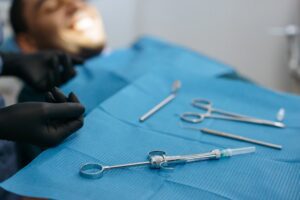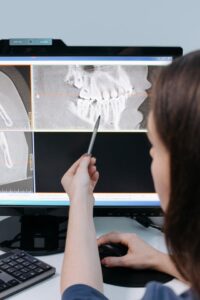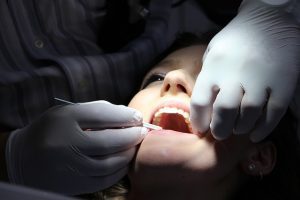Dental x-rays are a common diagnostic tool used by dentists to help diagnose problems with teeth and gums, but are they safe? This question is often on the minds of patients, and while dental x-rays do carry some risks, they are considered to be very safe when used appropriately. In this blog post, we’ll take a look at the risks associated with dental x-rays and what you can do to minimize those risks. We’ll also discuss why dental x-rays are an important part of routine dental care. So if you’re curious about dental x-rays, keep reading!
How Do Dental X-Rays Work?
You may be familiar with x-rays in the sense of what they are, which is a form of radiation. Radiation is a common part of our everyday lives due to energy being constantly emitted. Radiation comes in two forms: particles and traveling rays. Traveling rays are known as electromagnetic radiation, created by photons traveling in regular waves at the speed of light.
Forms of electromagnetic radiation include x-rays, radio waves, microwaves, visible light, ultraviolet light, and gamma rays. X-rays contain more energy than visible light because they have shorter wavelengths and higher frequencies.
In dental practice, x-ray machines function by producing a narrow beam of photons. This beam can pass through the body to capture images of your teeth and jaws. These x-rays, also known as radiographs, are done using digital sensors inside the mouth, or sensors located outside the mouth. The higher energy of x-rays allows them to pass through less dense parts of our body, such as the mouth. The calcium from bones and teeth absorbs the x-ray, allowing them to show up opaque white in the radiographs.
Different Types of Dental X-Rays
There are many different types of x-rays a dentist might use, and each serves a different purpose. The 6 types of dental x-rays include:
Intra-oral x-rays, which mean the film/sensor is in your mouth during the scan:
- Bitewing X-ray– Allows dentists to see decay between teeth or below the gum line. They can be done directly from the dental chair by the patient biting down on an x-ray film.
- Periapical X-ray– These are used to view the tip of the tooth root and the jawbone.
- Occlusal X-ray– These capture the roof or floor of the mouth, helping to identify problems with tooth development, fractures, cleft palates, or even unusual growths.
Extra-oral x-rays, which mean the film/sensor is outside your head during the scan:
- Panoramic X-ray– This x-ray captures an image of your entire upper and lower teeth, and is often used in preparation for dental procedures such as braces. It can also be used to diagnose problems such as jaw tumors.
- Cephalometric Projection– This is an x-ray of one side of your whole head. Commonly used by orthodontists for treatment plans, these can also be used to treat cancers and sleep apnea.
- Cone Beam X-ray– This method is used to convert 2D images into 3D pictures. This means your dentist can see every aspect and dimension of your teeth and surrounding bones. It is also a great tool to better identify where to place dental implants.
Are Dental X-Rays Safe?
It is normal to feel a bit wary about voluntarily exposing yourself to radiation. However, as technology has advanced, the amount of radiation used in dental x-rays, as well as patient exposure has dramatically decreased – it’s not really adding to your accumulation at all, especially when you consider that the amount of radiation used in dental x-rays is:
- Significantly less than what we are naturally exposed to from the Earth’s soil.
- Equivalent to using TVs, computers or smartphones.
- Comparable to radiation from building materials like granite counters or tile floors.
Regardless, we like to be as safe as possible, so protective equipment such as a lead apron or lead thyroid collar is used whenever you receive x-rays at the dentist. This equipment further minimizes radiation exposure.
If possible, x-rays should only be used when necessary to avoid unnecessary radiation exposure, but the benefits greatly outweigh any risks when it comes to preventing, detecting and correcting dental concerns.
If you are pregnant, it is best to avoid x-rays until you give birth, being as a fetus is more susceptible to problems than you are. However, if an x-ray is necessary, protective measures such as the lead apron will still make it safe. The same idea applies to children, as they could be more sensitive due to their small size.
Dental x-rays are an essential part of diagnosing many dental conditions. If you think you might have a dental issue that requires x-rays to diagnose, contact our office to schedule an appointment. Our dentists will determine if dental x-rays are necessary and explain the type of x-ray that will be used. We always prioritize the safety of our patients, so you can rest assured knowing that you’re in good hands with us.










